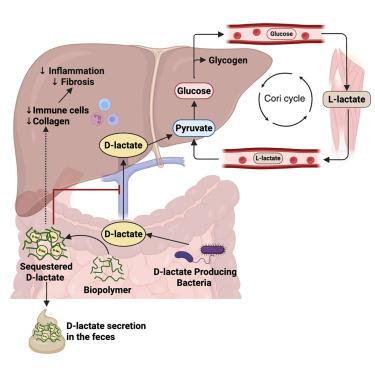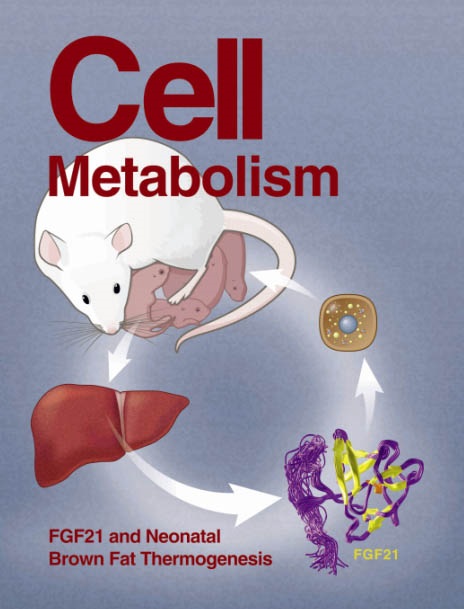Gut substrate trap of D-lactate from microbiota improves blood glucose and fatty liver disease in obese mice
IF 30.9
1区 生物学
Q1 CELL BIOLOGY
引用次数: 0
Abstract
L-lactate participates in metabolism, including the Cori cycle, but less is known about D-lactate. We found that circulating D-lactate was higher in humans and mice with obesity. D-lactate increased hepatic glycogen, triglycerides, and blood glucose more than equimolar L-lactate in mice. Stable isotope analyses showed that D-lactate is metabolized in mice and in hepatocytes to pyruvate, TCA intermediates, lipids, and glucose. The gut microbiota is the main source of blood D-lactate. Colonization of mice with a bacterial strain that produced D-lactate elevated blood glucose more than an L-lactate producer. Oral delivery of a biocompatible polymer that traps gut D-lactate, forcing fecal excretion, lowered blood glucose and insulin resistance in obese mice in a polymer length- and dose-dependent manner. This D-lactate trap lowered hepatic inflammation and fibrosis in mice with metabolic dysfunction-associated fatty liver disease (MAFLD)/metabolic dysfunction-associated steatohepatitis (MASH). Therefore, microbial-derived D-lactate contributes to host glucose and lipid metabolism and can be trapped to improve metabolic disease during obesity.

肠道底物捕获来自微生物群的d -乳酸改善肥胖小鼠的血糖和脂肪肝疾病
l -乳酸参与代谢,包括Cori循环,但对d -乳酸知之甚少。我们发现,人类和肥胖小鼠的循环d -乳酸水平更高。d -乳酸比等摩尔l -乳酸更能提高小鼠肝糖原、甘油三酯和血糖。稳定同位素分析表明,d -乳酸在小鼠和肝细胞中代谢为丙酮酸、TCA中间体、脂质和葡萄糖。肠道菌群是血液d -乳酸的主要来源。用一种产生d -乳酸的菌株定植小鼠,使其血糖比产生l -乳酸的菌株更高。口服一种生物相容性聚合物,可以捕获肠道d -乳酸,迫使粪便排泄,以聚合物长度和剂量依赖的方式降低肥胖小鼠的血糖和胰岛素抵抗。这种d -乳酸陷阱降低了代谢功能障碍相关脂肪性肝病(MAFLD)/代谢功能障碍相关脂肪性肝炎(MASH)小鼠的肝脏炎症和纤维化。因此,微生物来源的d -乳酸有助于宿主葡萄糖和脂质代谢,可以被捕获以改善肥胖期间的代谢性疾病。
本文章由计算机程序翻译,如有差异,请以英文原文为准。
求助全文
约1分钟内获得全文
求助全文
来源期刊

Cell metabolism
生物-内分泌学与代谢
CiteScore
48.60
自引率
1.40%
发文量
173
审稿时长
2.5 months
期刊介绍:
Cell Metabolism is a top research journal established in 2005 that focuses on publishing original and impactful papers in the field of metabolic research.It covers a wide range of topics including diabetes, obesity, cardiovascular biology, aging and stress responses, circadian biology, and many others.
Cell Metabolism aims to contribute to the advancement of metabolic research by providing a platform for the publication and dissemination of high-quality research and thought-provoking articles.
 求助内容:
求助内容: 应助结果提醒方式:
应助结果提醒方式:


